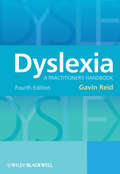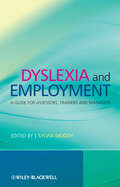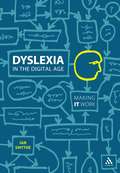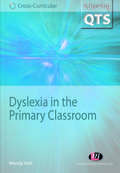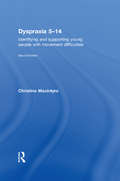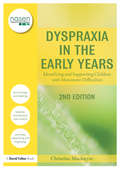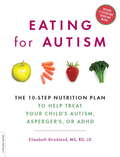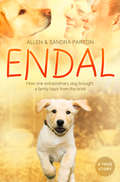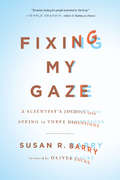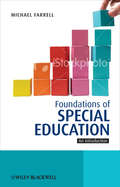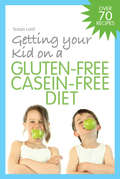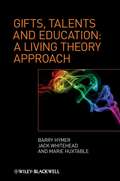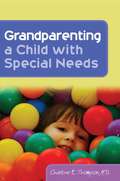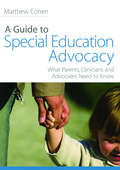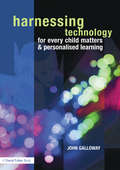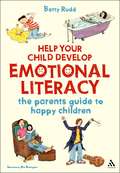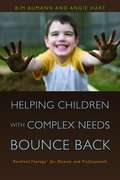- Table View
- List View
Dyslexia: A Practitioner's Handbook
by Gavin ReidThe main purpose of this new edition is to incorporate the most recent theoretical and practical research in the field of dyslexia and literacy and present it in a user friendly format for Practitioners. It refers to the most recent government reports on literacy and dyslexia in a number of countries such as, USA, UK, Canada, New Zealand and Australia. Each chapter has a summary at the start and, at the end, key points and 'points to consider' are looked at.
Dyslexia and Employment: A Guide for Assessors, Trainers and Managers
by Sylvia MoodyEdited by award-winning author Sylvia Moody, this jargon-free guide to good practice in dyslexia workplace consultancy, and related legal issues, provides comprehensive coverage in four clearly distinguished areas: Professional dilemma chapters discuss tricky issues which have arisen in practice. General perspective chapters take the viewpoint of professionals such as HR managers or trades-union representatives. How to do it right chapters offer advice on how to carry out diagnostic, workplace needs and legal assessments, and on devising training programmes. Information Point chapters provide brief information on general topics such as dyslexic difficulties in the workplace, emotional problems related to dyslexia, and the application of the Disability Discrimination Act. With contributions from leading experts on workplace consultancy, this definitive guide will be of interest to dyslexia professionals, managers, legal professionals, trades unions, coaches, mentors and careers advisors - as well as dyslexic employees and job-seekers.
Dyslexia in the Digital Age: Making IT Work
by Ian SmytheDyslexia is a complex condition, and every dyslexic needs a different solution. Technology is not that solution, but a part of the process to minimise the impact of dyslexia on individuals and to assist with the difficulties they face in everyday situations, so that they can demonstrate their potential in school or at work. This book takes the reader back to basics, from understanding the needs of the dyslexic individual to getting the most from available technology. It does this by providing frameworks from theoretical perspectives and following this through to practical implementation, including reviews of the most common types of software. There is plenty of practical advice on how to support dyslexic individuals using technology, including how to get the most out of what is available. It highlights state of the art technology, and suggests what more still needs to be done to make this technology truly enabling for all dyslexics.
Dyslexia in the Primary Classroom
by Wendy HallThis book is an important resource for all primary trainees. It provides an explanation of what dyslexia is and how it affects a child's learning, suggests simple activities which can be used to screen children ready for referral and outlines some easy-to-follow activities addressing different learning styles. It is full of practical suggestions on how to teach reading, spelling and mathematics, develop writing and help with classroom organisation for children displaying difficulties in these areas. The Primary National Strategy is considered throughout and clear links are made to the Professional Standards for the Award of QTS.
Dyspraxia 5-14: Identifying and Supporting Young People with Movement Difficulties (nasen spotlight)
by Christine MacintyreDyspraxia is increasingly common in young children. This fully revised and updated edition of Christine Macintyre’s invaluable companion explains the difficulties faced by children with dyspraxia in growing up and offers suggestions as to how these might be alleviated. In this book the children themselves, along with their parents and teachers, talk about how the difficulties change as the transition is made from primary to secondary school. Children with dyspraxia are frequently beset by frustrations as a result of their differences, can be misunderstood both at home and at school, and are very often bullied. This practical guide considers: the issue of giving children labels strategies to reduce stress the value of movement programmes raising self-esteem the transition to secondary school particular challenges faced during Puberty/adolescence handwriting as an indicator of dyspraxia. Including practical activities with additional material for secondary pupils this book shows children how to articulate their differences using individualised explanations, and then go on to succeed having recognised where their talents lie. Dyspraxia 5-14 is essential reading for teachers, parents, SENCos, teaching assistants and trainee teachers who want to improve their understanding of dyspraxia and its implications for children in Key stages 1-3.
Dyspraxia 5-14: Identifying and Supporting Young People with Movement Difficulties (nasen spotlight)
by Christine MacintyreDyspraxia is increasingly common in young children. This fully revised and updated edition of Christine Macintyre’s invaluable companion explains the difficulties faced by children with dyspraxia in growing up and offers suggestions as to how these might be alleviated. In this book the children themselves, along with their parents and teachers, talk about how the difficulties change as the transition is made from primary to secondary school. Children with dyspraxia are frequently beset by frustrations as a result of their differences, can be misunderstood both at home and at school, and are very often bullied. This practical guide considers: the issue of giving children labels strategies to reduce stress the value of movement programmes raising self-esteem the transition to secondary school particular challenges faced during Puberty/adolescence handwriting as an indicator of dyspraxia. Including practical activities with additional material for secondary pupils this book shows children how to articulate their differences using individualised explanations, and then go on to succeed having recognised where their talents lie. Dyspraxia 5-14 is essential reading for teachers, parents, SENCos, teaching assistants and trainee teachers who want to improve their understanding of dyspraxia and its implications for children in Key stages 1-3.
Dyspraxia in the Early Years: Identifying and Supporting Children with Movement Difficulties (nasen spotlight)
by Christine MacintyreToday there are more children than ever before in need of a variety of additional support needs, and many of these children have poor movement as a key contributory factor. Even in children with no specific ‘label’, movement is being found to be linked to learning, and educational professionals need to understand what is amiss and how to support children who do not meet their motor milestones at the correct time. The brand new topic areas featured in this comprehensive and practical new edition include: a discussion of terminology and labelling (in light of current inclusion guidelines) a range of age specific activities a section on the neurology of dyspraxia, showing the motor pathways that are energised and define motor competence a greater emphasis on balance, coordination and control examples from children of how movement is dependent on planning, sequencing and organising more practical activities that can form the basis of a programme to support the children. Practical strategies are provided throughout this authoritative book, so that teachers and other professionals can identify and understand movement difficulties, are empowered to support the children, and work effectively with the parents.
Dyspraxia in the Early Years: Identifying and Supporting Children with Movement Difficulties (nasen spotlight)
by Christine MacintyreToday there are more children than ever before in need of a variety of additional support needs, and many of these children have poor movement as a key contributory factor. Even in children with no specific ‘label’, movement is being found to be linked to learning, and educational professionals need to understand what is amiss and how to support children who do not meet their motor milestones at the correct time. The brand new topic areas featured in this comprehensive and practical new edition include: a discussion of terminology and labelling (in light of current inclusion guidelines) a range of age specific activities a section on the neurology of dyspraxia, showing the motor pathways that are energised and define motor competence a greater emphasis on balance, coordination and control examples from children of how movement is dependent on planning, sequencing and organising more practical activities that can form the basis of a programme to support the children. Practical strategies are provided throughout this authoritative book, so that teachers and other professionals can identify and understand movement difficulties, are empowered to support the children, and work effectively with the parents.
Eating for Autism: The 10-Step Nutrition Plan to Help Treat Your Child's Autism, Asperger's, or ADHD
by Elizabeth StricklandWhat your child eats has a major impact on his brain and body function. Eating for Autism is the first book to explain how an autism, Asperger's, PDD-NOS, or ADHD condition can effectively be treated through diet.Eating for Autism presents a realistic 10-step plan to change your child's diet, starting with essential foods and supplements and moving to more advanced therapies like the Gluten-Free Casein-Free diet. Parents who have followed Strickland's revolutionary plan have reported great improvements in their child's condition, from his mood, sleeping patterns, learning abilities, and behavior to his response to other treatment approaches. Complete with 75 balanced, kid-friendly recipes, and advice on overcoming sensory and feeding skill problems, Eating for Autism is an essential resource to help a child reach his full potential.
Eating for Autism: The 10-Step Nutrition Plan to Help Treat Your Child's Autism, Asperger's, or ADHD
by Elizabeth StricklandWhat your child eats has a major impact on his brain and body function. Eating for Autism is the first book to explain how an autism, Asperger's, PDD-NOS, or ADHD condition can effectively be treated through diet.Eating for Autism presents a realistic 10-step plan to change your child's diet, starting with essential foods and supplements and moving to more advanced therapies like the Gluten-Free Casein-Free diet. Parents who have followed Strickland's revolutionary plan have reported great improvements in their child's condition, from his mood, sleeping patterns, learning abilities, and behavior to his response to other treatment approaches. Complete with 75 balanced, kid-friendly recipes, and advice on overcoming sensory and feeding skill problems, Eating for Autism is an essential resource to help a child reach his full potential.
Endal: How One Extraordinary Dog Brought A Family Back From The Brink
by Allen Parton Sandra PartonThe remarkable story of Endal, voted ‘Dog of the Millennium’, and how, through his remarkable skills, companionship and unstinting devotion, he gave Allen Parton a reason to live again.
Fixing My Gaze: A Scientist's Journey Into Seeing in Three Dimensions
by Susan R. BarryA revelatory account of the brain's capacity for changeWhen neuroscientist Susan Barry was fifty years old, she experienced the sense of immersion in a three dimensional world for the first time. Skyscrapers on street corners appeared to loom out toward her like the bows of giant ships. Tree branches projected upward and outward, enclosing and commanding palpable volumes of space. Leaves created intricate mosaics in 3D. Barry had been cross-eyed and stereoblind since early infancy. After half a century of perceiving her surroundings as flat and compressed, on that day she saw the city of Manhattan in stereo depth for first time in her life. As a neuroscientist, she understood just how extraordinary this transformation was, not only for herself but for the scientific understanding of the human brain. Scientists have long believed that the brain is malleable only during a "critical period" in early childhood. According to this theory, Barry's brain had organized itself when she was a baby to avoid double vision - and there was no way to rewire it as an adult. But Barry found an optometrist who prescribed a little-known program of vision therapy; after intensive training, Barry was ultimately able to accomplish what other scientists and even she herself had once considered impossible. Dubbed "Stereo Sue" by renowned neurologist Oliver Sacks, Susan Barry tells her own remarkable journey and celebrates the joyous pleasure of our senses.
Foundations of Special Education: An Introduction
by Michael FarrellA unique cross-disciplinary critique of the foundations of Special Education. Covers legal, conceptual, medical, pharmacological, neuropsychological, social, behavioural, cognitive, psychotherapeutic, psycholinguistic, technological and pedagogical foundations Provides examples of how each foundation provides insights or practical contributions to special education generally, and to specific disabilities and disorders in particular Delivers information across all major types of disorder/disability in a single volume, creating a must-have reference for anyone involved in special education training, research or teaching
Getting Your Kid on a Gluten-Free Casein-Free Diet
by Susan LordGluten-free casein-free diets are widely used to improve cognitive function, speech patterns, behavior, and general well-being in children on the autistic spectrum. Written by a registered dietician and mother of a child who is thriving on a gluten-free casein-free diet, this practical guide covers everything from how to get your child on the diet, to daily meal plans, recipes and handy shopping lists. Susan Lord offers sound nutritional advice on how to implement the diet correctly, without harming your child by omitting major nutrient groups. Whether you are a parent or care-giver, this book will make removing gluten and casein from an autistic child's diet simple and stress-free. The easy-to-follow meal plans, complete with delicious recipes and ingredient lists, will guide you with confidence in providing a nutritionally-balanced diet for your child, as well as healthy meals the whole family will enjoy.
Getting Your Kid on a Gluten-Free Casein-Free Diet (PDF)
by Susan LordGluten-free casein-free diets are widely used to improve cognitive function, speech patterns, behavior, and general well-being in children on the autistic spectrum. Written by a registered dietician and mother of a child who is thriving on a gluten-free casein-free diet, this practical guide covers everything from how to get your child on the diet, to daily meal plans, recipes and handy shopping lists. Susan Lord offers sound nutritional advice on how to implement the diet correctly, without harming your child by omitting major nutrient groups. Whether you are a parent or care-giver, this book will make removing gluten and casein from an autistic child's diet simple and stress-free. The easy-to-follow meal plans, complete with delicious recipes and ingredient lists, will guide you with confidence in providing a nutritionally-balanced diet for your child, as well as healthy meals the whole family will enjoy.
Gifts, Talents and Education: A Living Theory Approach
by Barry Hymer Jack Whitehead Marie HuxtableGifts, Talents and Education: A Living Theory Approach is a practical guide for teachers on how to help all their pupils to enhance their gifts and talents in the classroom. Examples reveal how teachers can transform the way education is understood in schools, by relating stories of how they learned about their own gifts and talents. The book explains recent key developments in multimedia representations of social and emotional aspects of learning. These permit the multi-sensory gifts and talents of individual learners to be recognised and developed within a process that enhances the emotionally literate space of enquiring classrooms. Gifts, Talents and Education assumes a capability approach to human development which rests on enabling individuals to realise their gifts and talents within a co-created sense of the common good. The book offers values, skills and understanding as concepts that retain a direct connection with practice. The stories are grounded in the lives of practitioner researchers who show the lived meanings of these ideas as they are realised in practice, asking questions such as ‘how do I improve what I am doing?’ and ‘how do I live my values more fully in practice?’.
Grandparenting a Child with Special Needs
by Charlotte ThompsonWhen a new baby is born into a family, grandparents are excited about having a baby to enjoy and love. If the child is born with a disability, it can be difficult to know how to react and how best to help the child and the family as a whole. This book provides guidance on how to grandparent a child with special needs and give every grandchild the love and care they deserve and parents the added support they need. From coming to terms with a diagnosis, to helping with the transition from adolescence to adulthood, the book gives clear advice on grandparenting a child with special needs throughout their life. The author covers the medical, emotional and practical aspects of being a grandparent and explores important issues such as researching resources for specialized care, accessing financial and legal resources and, just as importantly, how to have fun and spend quality time with a grandchild with a disability. The book also addresses how to handle the diagnosis of a serious accident or progressive illness. Grandparenting a Child with Special Needs is a unique guide for grandparents keen to make a difference to the lives of their children and their grandchildren.
Grandparenting a Child with Special Needs (PDF)
by Charlotte ThompsonWhen a new baby is born into a family, grandparents are excited about having a baby to enjoy and love. If the child is born with a disability, it can be difficult to know how to react and how best to help the child and the family as a whole. This book provides guidance on how to grandparent a child with special needs and give every grandchild the love and care they deserve and parents the added support they need. From coming to terms with a diagnosis, to helping with the transition from adolescence to adulthood, the book gives clear advice on grandparenting a child with special needs throughout their life. The author covers the medical, emotional and practical aspects of being a grandparent and explores important issues such as researching resources for specialized care, accessing financial and legal resources and, just as importantly, how to have fun and spend quality time with a grandchild with a disability. The book also addresses how to handle the diagnosis of a serious accident or progressive illness. Grandparenting a Child with Special Needs is a unique guide for grandparents keen to make a difference to the lives of their children and their grandchildren.
A Guide to Special Education Advocacy: What Parents, Clinicians and Advocates Need to Know
by Matthew CohenDisability law can be complex and intimidating, so how can concerned parents use it to ensure their child with a disability receives the appropriate education they are legally entitled to? A Guide to Special Education Advocacy gives strategies for advocating for better provision of special education in schools. Despite the many services and accommodations that have been made for students with disabilities, such as the use of Braille or providing specialized education in a regular or special classroom, many children with disabilities do not get the services they need and are not placed in appropriate programs or settings. Because of this, the perception of disability often remains unchanged. Matthew Cohen's insightful manual gives a practical vision of how a parent or a professional can become an advocate to achieve a more inclusive and rewarding education for the child with a disability. This book will provide parents, people with disabilities, professionals and clinicians thinking about special education advocacy with an overview of current disability law and how it works, identifying practical ways for building positive and effective relationships with schools.
A Guide to Special Education Advocacy: What Parents, Clinicians and Advocates Need to Know (PDF)
by Matthew CohenDisability law can be complex and intimidating, so how can concerned parents use it to ensure their child with a disability receives the appropriate education they are legally entitled to? A Guide to Special Education Advocacy gives strategies for advocating for better provision of special education in schools. Despite the many services and accommodations that have been made for students with disabilities, such as the use of Braille or providing specialized education in a regular or special classroom, many children with disabilities do not get the services they need and are not placed in appropriate programs or settings. Because of this, the perception of disability often remains unchanged. Matthew Cohen's insightful manual gives a practical vision of how a parent or a professional can become an advocate to achieve a more inclusive and rewarding education for the child with a disability. This book will provide parents, people with disabilities, professionals and clinicians thinking about special education advocacy with an overview of current disability law and how it works, identifying practical ways for building positive and effective relationships with schools.
Harnessing Technology for Every Child Matters and Personalised Learning
by John GallowayThis book takes into account three core policies: 'Every Child Matters', 'Personalised Learning', and 'Harnessing Technology', combined they are at the heart of changes to children and young peoples’ experiences of school. Harnessing Technology considers these policies and their interlinked relationship. It outlines the ways in which technology allows us to assess, track and monitor pupil progress and use this information to better support both their learning and their broader needs, making it an essential resource for training and practicing teachers, school leaders, and all those involved in educational transformation. To achieve the five outcomes of the 'Every Child Matters' agenda requires an approach that is pupil centred, with developments in new technologies making it possible to not only understand each individual more precisely, but also for them to learn in more flexible and personalised ways. Through innovations such as web based information sharing, learning platforms and e-portfolios, schools will be able to offer content appropriate to pupil’s personal goals, breaching conventional orthodoxies of time and place. How far these policies will transform schools and services for children and young people remains to be seen. Consideration is given within the book to the barriers to their success, the issues that impinge upon them, and questions asked about their capacity to bring about long-term, systemic, change.
Harnessing Technology for Every Child Matters and Personalised Learning
by John GallowayThis book takes into account three core policies: 'Every Child Matters', 'Personalised Learning', and 'Harnessing Technology', combined they are at the heart of changes to children and young peoples’ experiences of school. Harnessing Technology considers these policies and their interlinked relationship. It outlines the ways in which technology allows us to assess, track and monitor pupil progress and use this information to better support both their learning and their broader needs, making it an essential resource for training and practicing teachers, school leaders, and all those involved in educational transformation. To achieve the five outcomes of the 'Every Child Matters' agenda requires an approach that is pupil centred, with developments in new technologies making it possible to not only understand each individual more precisely, but also for them to learn in more flexible and personalised ways. Through innovations such as web based information sharing, learning platforms and e-portfolios, schools will be able to offer content appropriate to pupil’s personal goals, breaching conventional orthodoxies of time and place. How far these policies will transform schools and services for children and young people remains to be seen. Consideration is given within the book to the barriers to their success, the issues that impinge upon them, and questions asked about their capacity to bring about long-term, systemic, change.
Help Your Child Develop Emotional Literacy: The parents' guide to happy children (Help Your Child to Succeed)
by Betty RuddThis book focuses on developing important qualities such as emotional awareness, confidence and self-motivation. It outlines simple steps to teach your child how to manage their feelings, behave appropriately and learn from their experiences. Packed full of tips, examples and fun activities, this easy-to-follow guide will give you the tools and confidence to nurture your child's emotional and mental wellbeing right from the start. Perfect for parents and carers, this book will also be a source of inspiration to teachers, teaching assistants, counsellors, psychotherapists and anyone wanting to boost a child's emotional wellbeing. Packed full of tips, examples and fun activities, this easy-to-follow guide will give you the tools and confidence to nurture your child's emotional and mental wellbeing right from the start. Perfect for parents and carers, this book will also be a source of inspiration to teachers, teaching assistants, counsellors, psychotherapists and anyone wanting to boost a child's emotional wellbeing.
Help Your Child Develop Emotional Literacy: The parents' guide to happy children (Help Your Child to Succeed)
by Betty RuddThis book focuses on developing important qualities such as emotional awareness, confidence and self-motivation. It outlines simple steps to teach your child how to manage their feelings, behave appropriately and learn from their experiences. Packed full of tips, examples and fun activities, this easy-to-follow guide will give you the tools and confidence to nurture your child's emotional and mental wellbeing right from the start. Perfect for parents and carers, this book will also be a source of inspiration to teachers, teaching assistants, counsellors, psychotherapists and anyone wanting to boost a child's emotional wellbeing. Packed full of tips, examples and fun activities, this easy-to-follow guide will give you the tools and confidence to nurture your child's emotional and mental wellbeing right from the start. Perfect for parents and carers, this book will also be a source of inspiration to teachers, teaching assistants, counsellors, psychotherapists and anyone wanting to boost a child's emotional wellbeing.
Helping Children with Complex Needs Bounce Back: Resilient Therapy for Parents and Professionals (PDF)
by Angie Hart Kim AumannBringing up a special child can leave parents feeling deskilled, disarmed, and worn down. A resilient child has the ability to cope with challenging situations, and the capacity to bounce back from trauma and gain long-term strength from these life experiences. Resilient Therapy ™ is an innovative way of strengthening children with complex needs. This is a tried-and-tested handbook for parents to read from cover to cover, or dip in and out of as needed. Accessible and fun, Helping Children with Complex Needs Bounce Back includes exercises and worksheets, as well as breaking down the principles of the latest research, making them easy to apply to everyday situations. This 'magic box' of ideas and remedies is perfect for parents and carers, friends and families of children with disabilities, special educational needs, and mental or physical health needs, as well as professionals working with these children.
